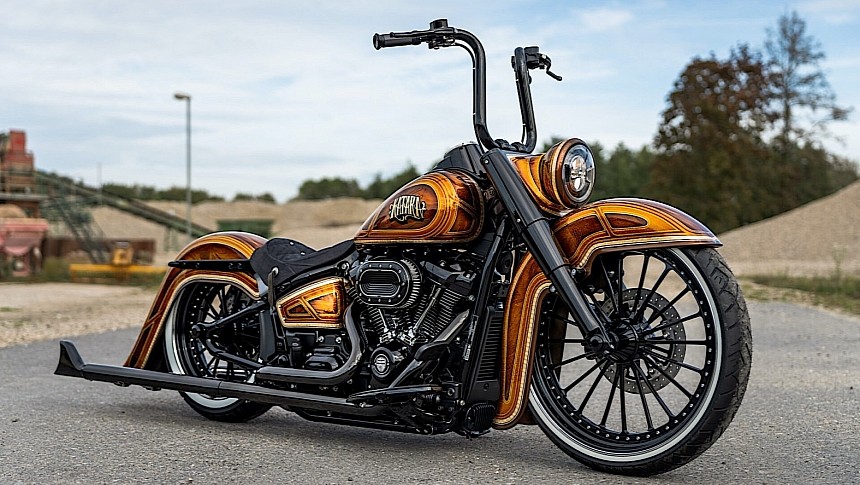The Chicano style of motorcycles is one of the most flamboyant the custom industry has ever come up with. Not only that, but it's also so difficult to approach properly that not many custom garages go for it.
Chicanos are, in general, low-riding motorcycles gifted with body parts so large (from the fenders to the fishtail exhausts) and colors and decorations so bright and intricate they are impossible to miss.
Associated with the Mexican way of life because of the other meaning of the word, Chicanos are mostly made in the United States because, obviously, Americans understand both the way of life and this type of builds the best.
But there is one custom crew over in Europe, one of the few doing this over there, that doesn't shy away from approaching this style. The shop is called Thunderbike, and it has quite a portfolio of such builds. A portfolio that grew a tad larger this week with the inclusion of something called Katara.
That's not exactly a word to bring forth Latin American vibes, but it was chosen for a good reason. The word is Arabic in origin (it means water droplet), and it was chosen because the guy who had this made lives over in Qatar – meaning that the already noticeable Chicano bike will be even more so over in the Middle East.
The ride on which the Katara was built was originally a Softail Heritage, but there's little of that left under the incredible paint job gifted with all that pinstriping and shine.
If you want to split hairs, the bike retained the original fuel tank, headlight, and engine, but not even they were left untouched. The fuel tank adopts the same paint job as the rest of the bike and becomes its central element, the headlight is now covered in a special cover that completely changes its look, and the engine, well, that one now rocks not only the telltale shape of the exhaust pipes, one to each side, but also a Screamin' Eagle Stage II torque kit.
Moving away from these elements, we see the two massive fenders installed front and rear, perhaps the biggest visual elements in the entire build. Underneath the front one hides a massive 23-inch wheel, offsetting in a terribly exciting fashion the significantly smaller, 18-inch wheel at the back.
Both rims are part of the Thunderbike New Digger series, and are backed by an air ride suspension system. The one at the back is further aided by a modified swingarm.
Thunderbike never says how much money one of their builds costs, but it does share the pricing for some (many) of the added parts. In the case of the Katara, they amount to a total of 11,600 euros, which is roughly $12,500.
The total cost of the bike is, naturally, a lot higher, but probably nobody cares about that. Certainly not its owner, and definitely not us, who only wish we'd get to see Chicanos on a more regular basis.
Associated with the Mexican way of life because of the other meaning of the word, Chicanos are mostly made in the United States because, obviously, Americans understand both the way of life and this type of builds the best.
But there is one custom crew over in Europe, one of the few doing this over there, that doesn't shy away from approaching this style. The shop is called Thunderbike, and it has quite a portfolio of such builds. A portfolio that grew a tad larger this week with the inclusion of something called Katara.
That's not exactly a word to bring forth Latin American vibes, but it was chosen for a good reason. The word is Arabic in origin (it means water droplet), and it was chosen because the guy who had this made lives over in Qatar – meaning that the already noticeable Chicano bike will be even more so over in the Middle East.
The ride on which the Katara was built was originally a Softail Heritage, but there's little of that left under the incredible paint job gifted with all that pinstriping and shine.
If you want to split hairs, the bike retained the original fuel tank, headlight, and engine, but not even they were left untouched. The fuel tank adopts the same paint job as the rest of the bike and becomes its central element, the headlight is now covered in a special cover that completely changes its look, and the engine, well, that one now rocks not only the telltale shape of the exhaust pipes, one to each side, but also a Screamin' Eagle Stage II torque kit.
Moving away from these elements, we see the two massive fenders installed front and rear, perhaps the biggest visual elements in the entire build. Underneath the front one hides a massive 23-inch wheel, offsetting in a terribly exciting fashion the significantly smaller, 18-inch wheel at the back.
Both rims are part of the Thunderbike New Digger series, and are backed by an air ride suspension system. The one at the back is further aided by a modified swingarm.
Thunderbike never says how much money one of their builds costs, but it does share the pricing for some (many) of the added parts. In the case of the Katara, they amount to a total of 11,600 euros, which is roughly $12,500.
The total cost of the bike is, naturally, a lot higher, but probably nobody cares about that. Certainly not its owner, and definitely not us, who only wish we'd get to see Chicanos on a more regular basis.






















